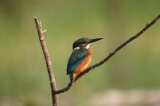Target species
Kingfisher (Alcedo atthis): Birds Directive – Annex I. Population size in project area – 120 pair. Nesting, overwintering and stable bird species. Conservation status – population disturbed and endangered. Kingfisher inhabits different water habitats; nests in steep banks. Food consits mailny of fish. Optimal ecological conditions: unregulated rivers with mosaic of flowing water and backwaters, trees and bushes on the banks, large amount of fish, steep river banks. There are restricted nesting conditions and food options in the project area.
Conservation issues: reduced river dynamics causes loss of potential nesting sites (steep river banks) and insufficient dietary offer (small fish); alternative nesting possibilities are insufficient (old sawyers). Project will help to improve nesting conditions and its maintenance within project area.
Sand Martin (Riparia riparia): Birds Directive – Annex I. Population size in the project area until 31.12.2011 – 0 – 300 pairs (significant annual variations). Nesting, migratory bird. Conservation status – threatened. Nesting of Sand Martin within the project area is restricted due to embanked of river and side arm banks as well as lowered flow dynamics – inside the river branch system no new steep banks are created anymore.
In the past there were huge nesting colonies of this species along the whole Danube and Morava section. Regular presence of Sand Martin and its nesting populations is nowadays significantly reduced. Majority of potential nesting sites (steep banks) was covered by large amount of stones and reduced water dynamics causes that new steep banks are created only exceptionally. Proposed project actions will help to improve nesting and feeding possibilities for this bird species.
European Bee-eater (Merops apiaster): Birds Directive – Annex I. Population size in the project area – 100 pairs (in Slovakia nest according to latest estimation 700 to 1 300 pairs). Nesting, migratory bird. Conservation status - near threatened.Significant part of the population is concentrated in southern part of Slovakia, while its distribution is influenced by the offer of suitable nesting habitats. Bee-eaters need for nesting steep loess or clay-sandy walls. The major part of their diet consists of hymenopterous insects (wasps, bees), dragonflies, butterflies and various beetles. Bee-eater catches its prey during flight. It lives in colonies.This bird is threatened mostly by degradation of steep nesting walls– their overgrowing by pioneer woody plants, establishment of landfills as well as reduction of food sources (large-scale use of insecticides causing significant loss of food). There are also known cases of direct persecution by plugging of nesting burrows and killing birds as a result of misunderstanding of its food behavior.

















